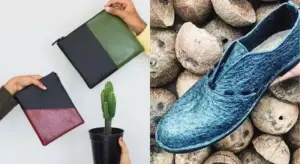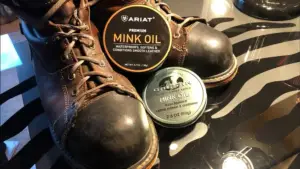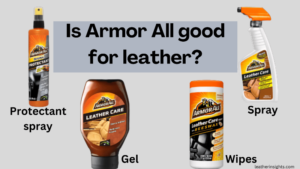Best Leather Color Restorer Balm & Cream 2023
In our previous article, we discussed the causes of leather discoloration and offered several remedies. To restore the color of your products, one of the solutions we suggested was to use a leather restoration kit.
Therefore, in this article, we’re going to talk about some of the best leather color restorer creams or balms that will help you get rid of the discolored spots and patches on your leather goods.

It’s crucial to keep in mind that leather restorative kits are available in a variety of colors to match your articles and accessories so choose the one that will work best for you.
Additionally, they are available in several sizes, allowing you to pick one based on the goods you wish to restore. This could be a leather jacket, a couch, a chair, a skirt, or a pair of leather pants or shoes.
What is the best leather color restorer?
A leather color restoration kit is used to revive the color of goods made of leather, which have become faded, lightly scuffed, damaged, or worn out. These items may include leather furniture like sofas and couches or leather clothing, shoes, and boots.
1. Furniture clinic leather recoloring balm
Furniture clinic leather recoloring balm is one of the highly recommended recoloring balms due to its ease of use, affordable price, and availability in 16 different unique colors.
When we tested this balm, we noticed that it absorbs easily into all absorbent leathers such as bi-cast leather, aniline, semi-aniline, and pigmented among others.
In addition, it worked perfectly on all leather items including bags, couches, shoes, and horse-riding leather items like a horse saddle.
We used it to repair small pet scratches, faded leather sofas, minor peeling on leather jackets, or simply refresh the look of car seats.
And the good thing is that the Furniture clinic re-coloring balm did not rub off on clothing since it got absorbed quickly into the leather.
But, remember to do a water test first to make sure your leather product is absorbent and does not have a refinished coating on the surface as this will prevent it from absorbing the color.
How much of the re-coloring balm do you need?
According to Furniture Clinic, 250ml of this re-coloring balm is enough to refinish a three-piece leather suite (sofa). That’s a generous amount!! So you can determine how much of the balm you need based on that.
However, on the downside, we found that we had to apply several coats in order to get the best results. Also, we needed to let items dry completely before using them so that they won’t stain clothing.
2. Coconix Leather Recoloring balm
Coconix Leather Recoloring Balm is another highly recommended kit based on experience and customer reviews.
It comes in three colors only; dark brown, medium brown, and pure black.
During our test, we found that this kit clears stains and faded leather and it can be used not only on leather but also on faux leather and vinyl products. This means that it works effectively even on non-absorbent leather items.
To get the best results, we applied several thin layers of the balm for a few hours and allowed each coat to dry before the next layer. But be careful not to use too much as a little goes a long way.
By applying several layers, we were able to repair cracks, peeling, scratches, and scuff marks on our leather items/
The benefit of Coconix recoloring balm is that it not only revives and refurbishes leather but also conditions and protects it against sun damage.
On the downside, however, this balm is not ideal for spot repair. This is because you might not match the color perfectly. So it is recommended that you recolor the whole item during the repair.
Before purchasing this balm, Coconix Company strongly recommends you contact them first via email or Facebook.
They also request that you send them clear pictures of the damaged leather items that you plan to repair. The reason for doing this is to help you choose the most suitable repair kit for your leather and guide you on how to do the repair to get the best results.
3. Drtulz leather recoloring balm
Drtulz recoloring balm is an easy DIY kit for leather color restoration. It can be used on any genuine leather items including upholstery, car steering wheel, shoes and clothing, saddle, and vinyl products.
One of the main benefits of Drtulz leather balm that we noticed when testing this product was that it did not rub off once it dried. Also, it conditioned and added a protective finish to the leather items that made them waterproof.
A little of this cream was able to repair damage ranging from minor scratches and fading to medium tears, burn holes, and cracks.
Moreover, it did not leave a sticky or tacky feeling on the leather surface and it came with all the items we need for the application.
For the best results, always ensure the leather is clean, dry, and not placed directly under the sun.
On the downside, we found that Drtulz balm does not do not work on non-absorbent leather. So remember to do the water test we talked about above on the leather before buying this color kit.
How to choose a leather color restoration kit
Keeping the following things in mind will help you choose a quality cream or balm to restore your leather goods:
-
Color
Color should be the first factor to consider when buying a repair kit for your leather product. As mentioned earlier, repair kits match your products in different colors.
For instance, Furniture Clinic has about 16 different colors. However, the colors don’t come in one pack so you need to buy the specific color that you want.
If you can’t find your desired color, don’t worry because there are brands that offer custom colors. All you need to do is send them a sample and their color technicians will advise accordingly.
-
Leather type
Some color repair kits are not meant to be used on certain types of leather while others can be used even on vinyl or PVC.
In most cases, the re-coloring balm or cream will get absorbed into the leather so that it can help to repair the scratches and rejuvenate the color from deep within the fibers. This means that you need to make sure your leather type is absorbent; that is, it shouldn’t have a finish on top.
If you are wondering whether your leather furniture or garment is absorbent, this is how to do the water test as stated by Furniture Clinic;
“If you have a non-absorbent type of leather, it will show if the water you applied to it forms beads on the surface or rolls over the surface without getting absorbing. On the other hand, you know you have leather that is absorbent if the water soaks right in and even darkens the leather where it has absorbed”.Source.
However, this does not mean that you cannot repair a non-absorbent or refinished piece of leather. You can use a leather touch-up kit or a leather colorant kit. We shall talk more about this in our next article.
-
Leather repair type
Consider the type of repair you want to do on your leather items before buying your restoration kit.
Leather damage ranges from minor to deep scratches, fading, stains, tears, cracks, burn holes, and peeling. So you need a suitable color kit that can repair the particular issue you have.
Most color restoration creams will restore the color on faded or stained leather as well as minor repair scratches and scuff marks but you might need specialized kits for holes, tears, and cracks such as leather patch kits.
Conclusion
To conclude, consider the following elements when selecting the best leather color restorer cream or balm to restore your leather goods:
- The color of the recoloring kit and the leather items you want to repair
- Type of leather used on your products. Most recoloring balms work on absorbent leather.
- The type of leather repair you want to do. Some deep tears and holes might not be covered completely by recoloring. A leather filler might be more appropriate for extensive damage to the leather.
Citation
Barron, J. (2017). How to Determine the absorbency of Leather. Furniture Clinic. Available at https://www.furnitureclinic.com/blog/absorbency-of-leather/








